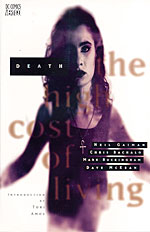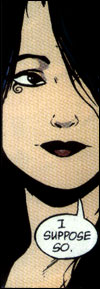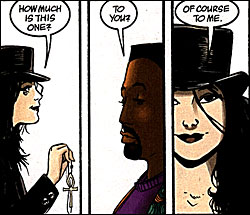
 Writer: Neil Gaiman
Writer: Neil Gaiman
Artists: Chris Bachalo, Mark Buckingham, Dave McKean
Colourist: Steve Oliff/Olyoptics
Letterer: Todd Klein
Collects DEATH: THE HIGH COST OF LIVING #1-3 and 'Death Talks About Life'
Price: $12.95
Publisher: DC Vertigo
ISBN: 1-56389-133-6
Sexton Furnival (he's pretty much used to his name by now) wants to kill himself. He doesn't love anyone. He doesn't hate anyone. There's no point to anything. So, he goes for a walk and comes to a garbage dump. A fridge falls on him, and he's rescued by Death, which has to show him that life is, at least, ironic. It's that time of century again, that one day in every one hundred years when Death becomes mortal to better comprehend the richness of the lives she takes.
"I bet I know where you got the idea from," Sexton tells her later on. He doesn't believe she's Death, and he's only hanging around her because she wants him to. "I saw a movie once. One of those late night things, starring nobody you've ever heard of. Death spent a day mortal in that."
DEATH: THE HIGH COST OF LIVING, in case you haven't realised, tells the story of Death's one day alive in the 20th Century. This was one of the key books that helped launch Vertigo ten years ago. A no-brainer too: Neil Gaiman, writing one of his most popular and recognisable characters. It's also the original SANDMAN spin-off, and, in my opinion, the one best.
 At the time of it's original publication, it racked up higher sales than it's parent book, and it's easy to see why. Death is a popular character, the oft-mentioned masterstroke by Gaiman when it came to creating the Endless, a family of anthropomorphic personifications of Destiny, Death, Dream, Destruction, Desire, Despair and Delirium.
At the time of it's original publication, it racked up higher sales than it's parent book, and it's easy to see why. Death is a popular character, the oft-mentioned masterstroke by Gaiman when it came to creating the Endless, a family of anthropomorphic personifications of Destiny, Death, Dream, Destruction, Desire, Despair and Delirium.
He already had a tall, gaunt, pale, depressed protagonist (of sorts) in Dream, so he came up with the opposite for Death; a mixture of cute looks, perky, girl-next-door attitude and a footnote from the Cabala. This Death was someone everyone would look forward to meeting. From her first appearance in SANDMAN #8, quoting MARY POPPINS ("Supercalifragilisticexpialidocious!" which, of course, is just another way to say one of Death's favourite phrases, "Peachy keen!"), it was a sure thing that Death was going to be a hit.
Death touches everyone with her actions here, but in a different way than she usually would. Being a Neil Gaiman story, THE HIGH COST OF LIVING is filled with the usual assortment of human and not-so human oddballs. There's Sexton, Death's unlikely companion; the blind Eremite, who's been waiting for Death to return, and his apprentice, the creepy "sex in bluejeans" Theo; 250-year-old Mad Hettie, who wants Death to help her find her missing heart (a familiar motif in a lot of Gaiman's work); and Hazel and Foxglove.
Mad Hettie, Hazel and Foxglove will be familiar to SANDMAN readers, but you don't need to know who they are in order to enjoy the story. This is something that appealed to me when I first started reading SANDMAN. Gaiman used the structure and symbolism of superhero comics to train readers in how to read SANDMAN. This went even further when it came to THE HIGH COST OF LIVING (and was taken to ludicrous extremes with THE DREAMING series).
 I first picked up the DEATH trade at the same time I picked up the first SANDMAN trade, PRELUDES AND NOCTURNES, as part of an enforced superhero purge when I was younger. SANDMAN, or at least the first volume, had cartoony art for the most part, and the stories, to my superhero-starved brain, were okay. It wasn't until I got further into the volume with the story '24 Hours', and further still with Death's first appearance in 'The Sound of her Wings', that I realised this was unlike any comic I had ever read. Once I read THE HIGH COST, and the rest of the SANDMAN series, I realised how thought out and intertwined the stories were. This was continuity on a level I wasn't used to.
I first picked up the DEATH trade at the same time I picked up the first SANDMAN trade, PRELUDES AND NOCTURNES, as part of an enforced superhero purge when I was younger. SANDMAN, or at least the first volume, had cartoony art for the most part, and the stories, to my superhero-starved brain, were okay. It wasn't until I got further into the volume with the story '24 Hours', and further still with Death's first appearance in 'The Sound of her Wings', that I realised this was unlike any comic I had ever read. Once I read THE HIGH COST, and the rest of the SANDMAN series, I realised how thought out and intertwined the stories were. This was continuity on a level I wasn't used to.
But this is the beauty of THE HIGH COST: You don't need to know that Mad Hettie knows John Constantine or Morpheus. You don't need to know who Hazel and Foxglove are, or that there are big things to come for them. Death makes references to her family, but doesn't name them. You don't need to know who or what the Endless are, or to have even read SANDMAN. But the references are there, open and natural, linking everything together in a way that Chris Claremont never dreamed of, and actually rewarding the reader.
Something that makes THE HIGH COST an interesting artefact for younger readers to take note of is that it features Chris Bachalo's art at its best. You can actually understand what's happening, with beautifully realised characters and locations. People appear natural, with all the shapes and sizes that we really come in. The art captures the bright and shadowy streets of New York at night just as easily as the grit and grime of a basement containing a dead body and boxes of junk. This is some of Bachalo's earliest art, and it makes you wonder why and how he turned his pencils to the horribly distended figures and confusing panel layouts of STEAMPUNK. He draws the best Death.
The collection also includes 'Death Talks About Life', which was originally a seven page pamphlet available free at comic shops, in which, well, Death talks about life, and sex, and AIDS. Written by Gaiman and featuring rare pen and ink art by Dave McKean, it skims through the basics of safe sex and how to put a condom on (featuring a cameo by John Constantine and a banana). It's a strange exercise, harkening back to the days of Superman fighting drugs. I'm surprised they don't use this strategy more.
Oh well, maybe if more kids start reading comics...

This article is Ideological Freeware. The author grants permission for its reproduction and redistribution by private individuals on condition that the author and source of the article are clearly shown, no charge is made, and the whole article is reproduced intact, including this notice.


